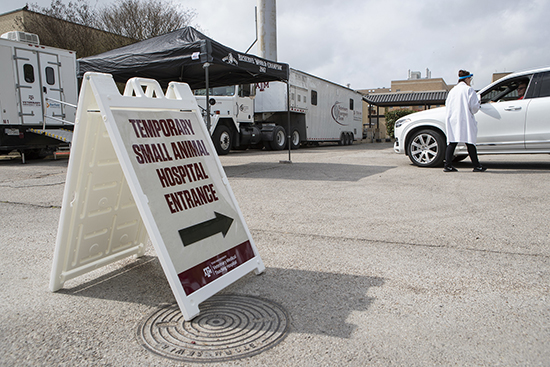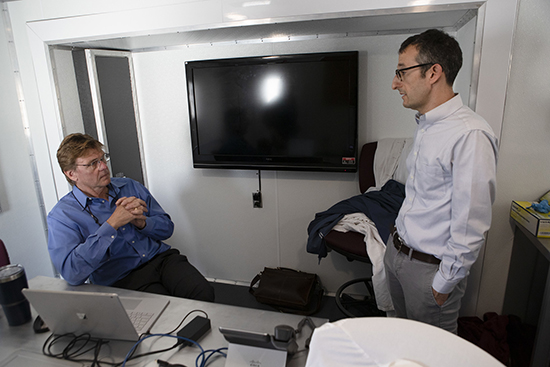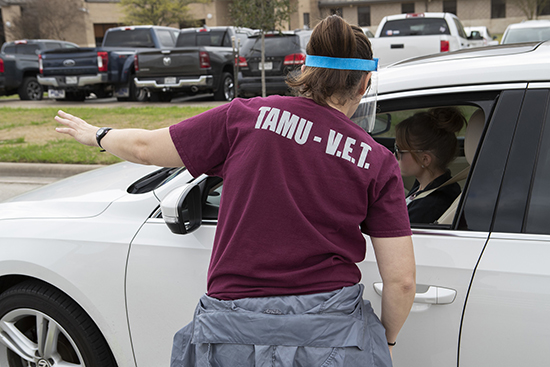Texas A&M Veterinary Medical Teaching Hospital Implements Changes To Protect Staff, Clients
Story by Aubrey Bloom, CVMBS Communications
4/21/2020 Texas A&M VMTH Curbside Admission, Discharge Update
COVID-19 Update, FAQs As VMTH Continues Operation During Shelter-In-Place

The most important thing small animal clinical sciences department head Dr. Jonathan Levine wants people to know about the Texas A&M Veterinary Medical Teaching Hospital’s (VMTH) response to the COVID-19 pandemic is what hasn’t changed, and that’s the standard of care inside the hospital.
On the outside, however, people will notice some changes that have been implemented to protect both humans and animals.
The biggest changes are that the VMTH is currently accepting only emergent and urgent cases so that the hospital can direct resources to those animals most in need of medical care and that clients will no longer leave their cars during the admissions and discharge processes; to limit direct human-to-human contact and reduce the spread of germs, clients will drop off their animals.
“Our goals are to prioritize human health, our clients’ health, and our patients’ health, so the steps you’ll see us taking now, and in the future, really focus on that and on maintaining excellent patient care and student education,” Levine said.
The parking lot in front of the Small Animal Hospital (SAH) is closed, and all traffic should enter via Veterinary Way from Raymond Stotzer Parkway. Upon entering, a station has been set up where clients will be asked some basic screening questions and then will be instructed on where to proceed based on their answers.

Inside the hospital, the biggest change is due, in part, to a national shortage of personal protective equipment (PPE) like surgical masks for the hospital staff.
“We have shifted our operations a little bit in that we’re not seeing elective cases,” Levine said. “We think that’s in the best interest of the public because of the emerging shortages of personal protective equipment. We think it’s in the best interest of our staff and the animals. So, we will see animals that have urgent and emergent healthcare needs.”
“We want to provide the very best standard of care, and that hasn’t changed at all,” he said. “So, the most critical patients, those that just can’t wait, we can provide outstanding service as we always have.”
The SAH is also expanding its use of VirtualVet, a telemedicine portal, for rechecks and other services to minimize trips to the hospital. For information on VirtualVet availability, clients can email virtualvets@cvm.tamu.edu or call 979-845-2351.
The SAH had assistance in quickly making the necessary changes from the Texas A&M Veterinary Emergency Team (VET), which has extensive experience in rapid response situations.
“The VET’s done amazing things throughout the state, whether it’s wildfire response, chemical disasters, or hurricanes,” Levine said. “They are an amazing service arm of this college. What they’ve done for us here is helped us operationalize emergency plans for our hospital very quickly. A lot of this had to happen very quickly once we realized the full scale of the COVID-19 outbreak.”

VET members are assisting with screening questions that are designed to identify not only the current status of the animal but also whether the owner is at risk of having been exposed to COVID-19.
According to VET director Dr. Wesley Bissett, anyone experiencing flu-like symptoms should have someone they trust and who hasn’t been exposed bring their animal to the VMTH; however, the hospital is prepared to handle situations where that’s not possible.
Though at this point there has been no indication that animals are carriers of the disease, the VET is washing the animals of clients identified as higher risk to make sure they aren’t carrying the virus on their coats.
Above all, Bissett, like Levine, wants to assure the public that these changes have been implemented so that the VMTH can continue to provide the standard of care it’s known for.
“We haven’t had any COVID-19 diagnoses at the Small Animal Hospital,” Bissett said. “We aren’t doing this because we have a disease problem internally; that’s not what’s behind it. What’s behind it is we need to stay fully functional and healthy. That means we need our clinicians here and we need our staff here. Our best way for us to do that is to make sure that we don’t inadvertently introduce the virus into the large or small animal hospital.”
See more photos of the Small Animal Hospital “Drive-thru” here.
###
For more information about the Texas A&M College of Veterinary Medicine & Biomedical Sciences, please visit our website at vetmed.tamu.edu or join us on Facebook, Instagram, and Twitter.
Contact Information: Jennifer Gauntt, Director of Communications, Texas A&M College of Veterinary Medicine & Biomedical Sciences; jgauntt@cvm.tamu.edu; 979-862-4216


